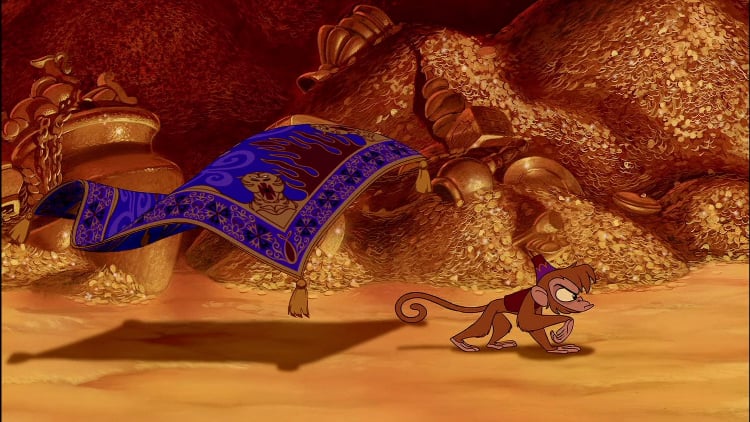Animating the Inanimate | Anthropomorphism in Object Animation
Following on from our article on Men and Beasts: Anthropomorphism in Character Animation, we at Headstuff want to bring you a look at another aspect of anthropomorphic representation with this second part about everyday household objects and the characterisation that can be placed on these.
“Okay, the flying carpet is going to have its own personality.”
“Wow, that sounds interesting.”
“It doesn’t speak though.”
“Wait..what?”
“It feels.”
“Yes.”
This is how I imagine the Disney board room meeting for 1992’s Aladdin film to have gone. Now, I may be using a little bit of artistic licence here but, all the same, the character of the flying carpet feels. It emotes. It is quite fascinating that something such as a flat rug with no facial expression or dialogue can convey as much emotion as it does. That is anthropomorphism in inanimate objects.

Disney took a concept attributed to Arabian lore and ran with it, making the tassels at each corner work like limbs, adding squash and stretch animation principles to the character, it standing strong when happy and proud and hunching in a slump when saddened. The sheer fluidity of motion is so strong that vocals are never necessary for this character. This can be seen multiple times in animation, taking what seems like an everyday object, throwing a spin on it, letting our imaginations flow onto the screen.
Let’s look at an earlier example that is just as beautiful but combines stunningly characterised animation with a tightly-weaved narrative. “The Sorcerer’s Apprentice” segment from Fantasia, (1940), is one of Disney’s earliest and most groundbreaking works. An attempt to boost the popularity of Mickey Mouse in a post-Snow-White world, Fantasia allowed an animation to be dictated almost entirely by its musical score.
In this segment, Mickey, in an attempt to remove himself from an apprentice position, uses the knowledge of his master to animate his tools so that they will complete his chores for him. Chaos naturally ensues as our protagonist tries to stop the building disaster. It isn’t Mickey that makes this though; it is the style and anthropomorphic qualities of the emotively drawn brooms that really stand out.
The broom head acts as legs, leading to a broom handle that acts as a head. The thing is, we never really see this; it is nothing more than a broom and yet, the incorporation of animation principles, such as the staging, follow through and overlapping action allows for our minds to perceive the human qualities within the subject and it is an incredible study into the personification of the human mind.
A later example from Disney is from the animated Beauty and the Beast (1991), which exemplifies the concept of anthropomorphism. Mrs Potts, Cogsworth, Lumière and Chip, putting their excellently attributed names aside, are a gorgeous representation of how inanimate objects can thrive in an animated setting. Potts and Chip highlight a very relatable mother-and-son relationship; the natural motherly qualities and curiosity of a child, respectively, accurately portraying the reality of such characters in our own world.
The incorporation of these traits, from the romantic personality of our French candelabra to his interactions with our protagonist creates a sense of connection to our characters that boosts relatability to our own experiences. I mean, the hands on Cogsworth’s clock face are clearly meant to be a moustache. This clever visual play shows that, in animation, anything can be used to understand our world and depict emotion through fantasy.
Finally, let us look at something that many of us probably overlook when we watch a Pixar film. Remember the famous logo of Pixar? A lamp hops across the screen, crushes the I and looks at the camera. This synonymous intro has been parodied countless times but its origins lie in John Lasseter’s 1986 animated short, Luxo Jr. about a parent and child lamp playing with a ball together. This two-minute short, although sounding boring, is simple but classic animation which showed the capabilities of Pixar in its simplicity.
Shown at the SIGRAPH computer animation conference, Luxo Jr., in only two minutes, provides us with a fulfilling precursor to the anthropomorphism that would follow and shows us the possibilities of characterisation within the 3D artform. In the moment that the ball deflates, we can really feel for the young character, something which to us may be nothing, really affects the protagonist before it moves its attention to something better. Lasseter has said in interviews that he was asked whether the senior lamp was a mother or father and, in that moment, the realisation that he was onto something became apparent.
https://www.youtube.com/watch?v=6G3O60o5U7w
This animation, although only short, has provided a landmark and milestone for future animations allowing storytellers to experiment with inanimate objects, creating more imaginative and out-there concepts and character designs for animated films. It is these innovative moments that has allowed anthropomorphism to thrive and build upon a basis, be it through animals or household objects. Animation has a way of speaking to us and connecting with us through these styles, allowing us to empathise with the actors on screen, no matter who or what they are.

